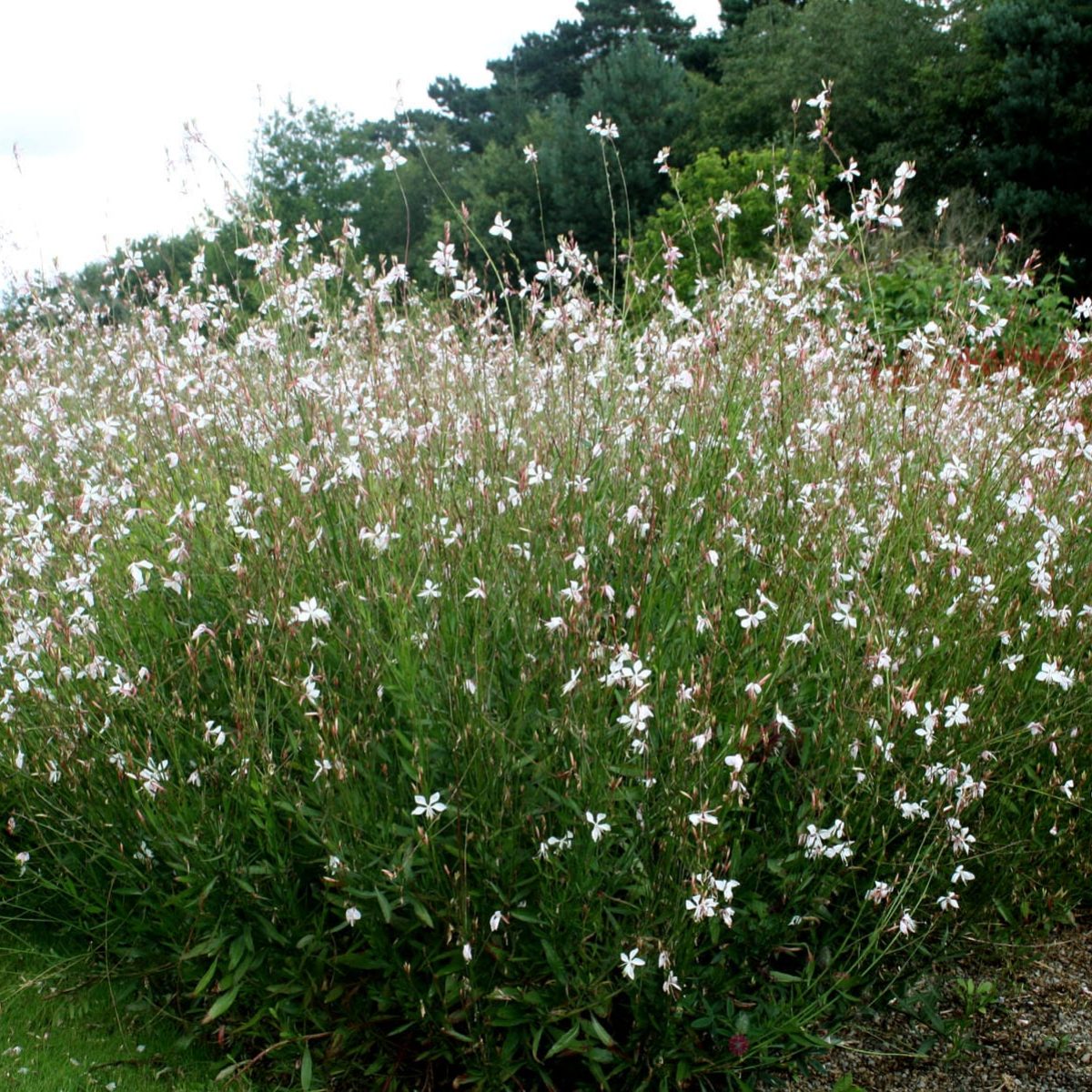Gauras aren’t just delicate perennials—they’re graceful performers. With their airy wands of butterfly-like blooms and wispy foliage, they bring motion and softness to borders, cottage gardens, and drought-tolerant landscapes. Their easygoing nature and extended bloom time make them a favorite among designers who value both effortlessness and elegance.
Whether swaying in a prairie planting, softening a gravel bed, or adding whimsy to a mixed border, gaura offers a long-lasting show of movement, pollinator appeal, and romantic charm that carries from spring through frost.

Portrait of the Gaura
A member of the Onagraceae family, gaura is native to North America and is especially prized for its long bloom time and tolerance of poor soils. Though often listed under Gaura lindheimeri, it’s now classified as Oenothera lindheimeri.
- Type: Perennial (short-lived in colder zones)
- Family: Onagraceae
- Common Names: Gaura, Bee Blossom, Wand Flower
Foliage and Form
Gaura grows in a loosely bushy, upright form, sending out long, slender stems that sway elegantly with the breeze. Its narrow leaves are often tinged red or spotted with purple.
- Height: 60–120 cm (2–4 ft)
- Spread: 30–60 cm (1–2 ft)
- Growth Habit: Clumping base with airy flowering stems
Blooms and Fragrance
From early summer through fall, gaura blooms almost continuously. Its delicate, four-petaled flowers resemble butterflies and are borne on long, wispy stems that create constant movement.
- Bloom Time: May to October
- Color: White, pink, rose, or bi-colored
- Fragrance: Light, slightly sweet
The Right Time to Plant, Flower, and Prune Gaura
| Month | Planting | Flowering | Pruning |
|---|---|---|---|
| January | ❌ | ❌ | ✅ Cut back to base if needed |
| February | ❌ | ❌ | ✅ Remove winter damage |
| March | ✅ Sow indoors | ❌ | ✅ Trim old stems |
| April | ✅ Transplant | ❌ | ❌ |
| May | ✅ Plant outdoors | ✅ Start | ❌ |
| June | ✅ Water well | ✅ Peak | ✅ Light deadheading |
| July | ❌ | ✅ | ✅ Deadhead to extend bloom |
| August | ❌ | ✅ | ✅ Light trim if leggy |
| September | ❌ | ✅ (slow down) | ✅ Tidy for fall |
| October | ✅ Divide clumps | ❌ | ✅ Cut back and mulch |
| November | ✅ Bare-root | ❌ | ✅ Protect roots in cold areas |
| December | ❌ | ❌ | ✅ Mulch base if in cold region |
✅ = Recommended ❌ = Not advised
Watering, Sunlight, and Environment for Gaura
Watering
- Low to moderate needs once established.
- In the first season, water regularly to help roots settle.
- Mature plants are drought-tolerant and prefer dry conditions.
Sunlight
- Prefers full sun for best flower production and strong stems.
- Can tolerate partial shade but may become floppy.
Indoor vs Outdoor
- Best grown outdoors in beds, borders, or large containers.
- Not suitable for indoor growing due to light and space needs.
Temperature
- Hardy in USDA zones 5–9.
- In colder zones, it may act as an annual or short-lived perennial.
- Protect from hard frosts with mulch at the crown.
Ideal Soil Conditions for Growing Gaura
| Soil Feature | Optimal Condition | Why It Matters |
|---|---|---|
| Soil Type | Sandy, loamy, or gravelly | Ensures drainage and root strength |
| Texture | Loose, airy | Prevents crown rot and promotes air flow |
| Drainage | Excellent | Gaura dislikes heavy, wet soils |
| Moisture | Dry to medium | Avoids fungal issues and root stress |
| Soil pH | Neutral to slightly acidic (6.0–7.0) | Supports nutrient uptake and healthy bloom cycles |
| Fertility | Low to moderate | Too much nitrogen results in weak, floppy growth |
Common Problems & Solutions
| Issue 🐾 | Symptoms 🔍 | Solutions 🛠️ |
|---|---|---|
| Root Rot 💧 | Wilting, yellow leaves, mushy roots | Improve drainage; water only when needed |
| Leggy Growth 🌿 | Sparse flowering, floppy stems | Full sun and occasional trimming |
| Aphids 🐜 | Sticky stems, curled tips | Spray with water or neem oil |
| Powdery Mildew 🍃 | White coating on leaves | Prune for airflow; apply organic fungicide |
| Poor Blooming 🌸 | Green growth but few flowers | Reduce feeding; ensure enough sunlight |